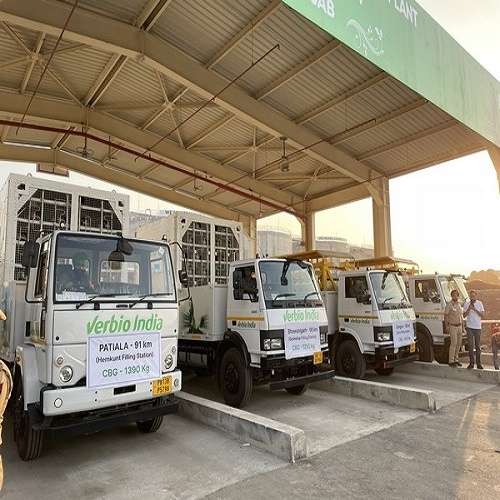Chandigarh [India], November 12 (ANI): Asia’s largest bio-energy plant was commissioned in Bhuttal Kalan near Sangrur in Punjab in late October. Germany-based Verbio Group’s Indian subsidiary, built the plant, leading bioenergy companies and an Indian subsidiary, at the cost of 230 crores. It is spread over 20 acres.
It is the first, largest and state-of-the-art, only of its kind in India as well as in entire Asia. India’s Minister of Petroleum and Natural Gas and Housing and Urban Affairs, Hardeep Sing Puri, and Chief Minister of Punjab Bhagwant Mann were present at the inaugural ceremony.
Addressing the gathering, the chief minister said, “This is the largest biofuel (biomethane/bio-CNG) production unit in India with 33 TPD (tonnes per day) capacity of BioCNG, 650 TPD (tonnes per day) of bio-manure., and the annual straw consumption in this unit will be 1.30 lakh tonnes.
This step will go a long way in wiping out the menace of paddy straw burning from the state.” Claus Sauter, VERBIO AG’s Founder and CEO, stated with great optimism: “In India we are entering a growth market for renewable energy with very large potential.”
It was built over the last three years under the Indian government’s Sustainable Alternative Towards Affordable Transportation (SATAT) programme since its launch in October 2018, and now supplies BioCNG into the retail network of the Indian Oil Corp. Ltd. (IOCL) on a commercial basis for automotive application in the Punjab region. The Compressed Bio Gas (CBG) plant has been running on trial since August, but it will now become fully operational.
It signifies the importance of technological innovation and investment for sustainable development, climate protection, and regional value creation in India. Its current production is about six tonnes per day (TPD) of CBG. The plant currently consumes 1, 00,000 tonnes of paddy straw from six to eight satellite locations within a 10-km radius.
Minister Puri said the plant would soon process 300 tonnes of paddy straw to produce 33 TPD of CBG using eight digesters. The CBG plant, which provides direct employment to 390 and indirect employment to 585 persons respectively, will also produce about 600-650 tonnes of fermented organic manure daily, which will be helpful in organic farming.
In addition, the plant is expected to reduce stubble burning on 40,000-45,000 acres, causing an annual reduction of 1, 50,000 tonnes of Carbon Dioxide emissions and 20,000 MT of fly ash currently produced due to paddy straw burning.
It will give a substantial relief in air pollution due to reduced stubble burning within a radius of at least 10 kilometres. It will provide large savings for farmers as the entire stubble collection is conducted free of cost to them.
The introduction of bio-manure will improve soil health as well as CBG is a climate-friendly and cost-effective fuel for automotive, industrial and can be produced at commercial scale.
With this state of the art technological innovation, India joined the League of Nations marching towards renewable energy-driven society that is capable of not only addressing the present day challenges of energy security, but also represents a way to deal effectively with the environmental concerns of the region. This plant will also support farmers and rural communities while implementing responsible environmental and energy policies.
Punjab Energy Development Agency (PEDA) has allocated 42 additional CBG projects based on paddy straw and other agro-residue with a total capacity of 492.58 tons per day (TPD). The Minister of New and Renewable Energy Sources in Punjab, Mr. Aman Arora, expressed in April that the state had been looking to develop a lasting and sustainable solution to the stubble-burning problem while also strengthening the rural economy at the same time.
Verbio group had shown keen interest in building more such plants in the state. If this pilot project is successful, the Chief Minister observed, the group may set up ten more such plants in the state.
Such projects were in line with the commitment of the state government to make the state clean, green, and pollution free. The state government has recently taken several steps to mitigate the problem of stubble burning.
Two more projects with a total capacity of 14.25-tonne CBG per day are expected to be launched in 2022-23. Minister Puri said the central government had taken every necessary step to help various state governments in development work. The commissioning of the CBG plant was part of India’s master plan for a CBG-based rural economy.
The plant will go a long way to resolve a significant environmental problem in Punjab. Given its intense cropping pattern of wheat and paddy, the state faces the problem of crop residue disposal.
The problem is severe in the case of the paddy straw, which has no other usage.
Therefore, there is considerable potential for paddy straw based CBG in Punjab. Hindustan Petroleum Corporation Ltd (HPCL) is setting up a paddy straw-based biogas project in the Bathinda district, with a capacity of 100 KL 2G ethanol per day. The project, which will consume about 2 lac tonne paddy straw annually, is likely to be ready by February 2023.
The Indian Ministry of New and Renewable Energy has long realized the potential of biomass energy in the Indian context. According to a recent MNRE study, the quantity of biomass available in India every year is 750 million metric tonnes. Out of that, about 230 million metric tonnes of biomass every year constitutes a surplus. It amounts to a potential of about 28 G.W.
It has therefore launched several programmes for the promotion of efficient technologies for its use in various sectors of the economy.
The Ministry has been executing a biomass power/cogeneration programme since the mid-nineties. So far, over 800 biomass power and bagasse/Non-bagasse cogeneration projects have been installed in the country, aggregating to 10170 MW capacity for feeding power to the grid.
Biogas is produced when bio-degradable organic materials or wastes are treated through a process called Anaerobic Digestion (A.D.) Cattle dung, biomass from farms, kitchens, gardens, industry, poultry droppings, night soil, and municipal wastes are some of the common examples of biodegradable organic material.
The digested slurry by-product from Biogas Plants is a useful source of nutrient-enriched organic manure. It contributes to improvement in crop yield and maintenance of soil health.
Even though India has 17 percent of the world’s population, it contributes only 5 percent in terms of harmful, a fact that Prime Minster Modi mentioned with some pride in his address during the COP26 summit in 2021.
He presented in that address five strategic targets to cope with the challenge of climate change. India will increase its non-fossil energy capacity to 500 GW by 2030. Renewable energy will provide for 50 percent of India’s energy needs at the same time.
India also committed to the reduction of total projected carbon emissions by one billion tonnes. By 2030, the carbon intensity of the Indian economy will be reduced to less than 45 percent. Finally, India committed to achieving the target of net zero emissions by 2070.
COP27 or the 27th instalment of the annual United Nations Climate Change Conferences, is due next week. COP27 must work against a complex and challenging backdrop: Russia’s war against Ukraine has not only forced millions to face acute hunger, but the heavy dependence on Russian energy sources, especially gas, has thrust Europe into an energy crisis.
Some countries are using it as an excuse to reinvest in fossil fuels, instead of pushing for renewables. However, the commissioning of Asia’s largest bioenergy plant in India on the eve of COP27 reflects its firm adherence to the commitments Prime Minister Modi had made last November at COP26 in Glasgow, the UK. (ANI)












